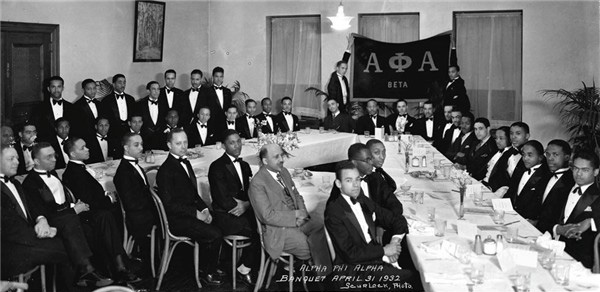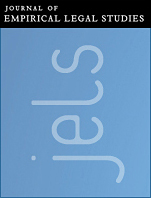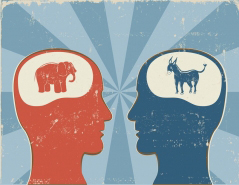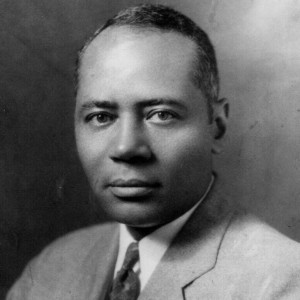Projects
African American Fraternal Networks
African American collegiate-based fraternities and sororities have been around since the early 1900s. Surprisingly, it wasn’t until the 1970s that people began conducting publicly accessible research on them. In the early 2000s, scholars began to closely analyze these groups, exploring their histories, culture, and contemporary issues. My work was part of that—a series of edited books focused on a broad analysis of black Greek-letter organizations (BGLO).
Since becoming a law professor, I’ve used a variety of research methods—e.g., historical, qualitative, quantitative—to explore the intersection of these organizations with the law. That work has fallen within two primary domains. One has focused on the role that these organizations have played in African Americans quest for civil rights and social equality. Contrary to the typ ical narrative about these groups, that legacy is robust and several findings emerge. First, among the nine major organizations their racial uplift engagement was not manifested in the same way, which could be due to gender dynamics as well as organization al identity. Second, across the board, their focus seems to have shifted from social justice and civil rights to community service and philanthropy.
My other area of focus has been with regard to hazing, its legacy, and why the law doesn’t constrain it. I also study how BGLO hazing cases are, can, and should be litigated in addition to problem-solving around this issue. What my research has found is that hazing has been a persistent problem within BGLOs, they are more physically violent than in comparison groups and have grown increasingly violent over the decades. Many factors undergird this type of hazing—e.g., a belief that it is useful and necessary for group survival, a culture of hyper-masculinity, organizational corruption at the top, limited understanding of the costs associated with the behavior. However, this doesn’t make litigation an easy win for plaintiffs, because any number of factors may underscore their appreciation for the risks associated with hazing either before or during the process.

African American Fraternities and Sororities: The Legacy and the Vision, 2nd Edition (Tamara L. Brown, Gregory S. Parks, & Clarenda M. Phillips eds., University Press of Kentucky) (2012).
ALPHA PHI ALPHA: A LEGACY OF GREATNESS, THE DEMANDS OF TRANSCENDENCE (Gregory S. Parks & Stefan M. Bradley eds., University Press of Kentucky) (foreword by Michael A. Blake) (2011).
BLACK GREEK-LETTER ORGANIZATIONS,2.0:NEW DIRECTIONS IN THE STUDY OF AFRICAN AMERICAN FRATERNITIES AND SORORITIES (Matthew W. Hughey & Gregory S. Parks eds., University Press of Mississippi) (foreword by Theda Skocpol) (2011).
BROTHERS AND SISTERS:DIVERSITY WITHIN AMERICAN COLLEGE FRATERNITIES AND SORORITIES (Craig L. Torbenson & Gregory S. Parks eds., Fairleigh Dickinson University Press) (foreword by Edward Whipple) (2009).
BLACK GREEK LETTER ORGANIZATIONS IN THE 21STCENTURY:OUR FIGHT HAS JUST BEGUN (Gregory S. Parks ed., University Press of Kentucky) (foreword by Julianne Malveaux and afterword by Marc Morial) (2008).
AFRICAN AMERICAN FRATERNITIES AND SORORITIES:THE LEGACY AND THE VISION (Tamara L. Brown, Gregory S. Parks, & Clarenda M. Phillips eds., University Press of Kentucky) (2005).
Wendy Marie Laybourn and Gregory S. Parks, The Sons of Indiana: Kappa Alpha Psi and the Fight for Civil Rights, __ INDIANA L.J. __ (2016).
Gregory S. Parks & Caryn Neumann, Lifting as They Climb: Race, Sorority, and African American Uplift in the 20th Century, __ HASTINGS WOMEN’S L.J. __ (2016).
Marcia Hernandez & Gregory S. Parks, Fortitude in the Face of Adversity: Delta Sigma Theta’s History of Racial Uplift, __ HASTINGS RACE &POVERTY L.J. __ (2016).
Wendy Marie Laybourn & Gregory S. Parks, Omega Psi Phi Fraternity and the Fight for Civil Rights,__ WAKE FOREST J.L.&POL’Y__ (2016).
Gregory S. Parks, Rashawn Ray, & Shawna M. Patterson, Complex Civil Rights Organizations:Alpha Kappa Alpha Sorority, An Exemplar, __ ALABAMA C.R.-C.L.L.REV. __ (symposium on The Ghosts of 1964: Race and Gender Inequity Fifty Years Later) (2015).
Gregory S. Parks, Shayne E. Jones, & Matthew W. Hughey, Hazing as Crime: An Empirical Analysis of Criminological Antecedents, 39 LAW & PSYCHOL. REV. 1 (2015).
Gregory S. Parks, “Midnight within the Moral Order”: Organizational Culture, Unethical Leaders, and Members’ Deviance, 40 T. MARSHALL L.REV. 115 (2015).
Gregory S. Parks, Shayne E. Jones, Rashawn Ray, Matthew W. Hughey, & Jonathan M. Cox, White Boys Drink, Black Girls Yell: A Racialized and Gendered Analysis of Violent Hazing and the Law, 18 J. GENDER,RACE, & JUST. 97 (2015).
Gregory S. Parks, Rashawn Ray, & Jonathan M. Cox, Menacing Monikers: Language as Evidence, 49 WAKE FOREST L.REV. 799 (symposium on Law as Violence: An Interdisciplinary Conversation) (2014).
African American Legal History
My research has explored the ways in which African American fraternities and sororities and their members have played a role in African American’s quest for Civil Rights and social equality. My research has found that many key actors during the Civil Rights Movement, especially lawyers and community organizers, were active members within African American fraternities and sororitie s. As noted in the section on “ African American Fraternal Networks” several other findings in this area emerge. First, among the nine major organizations, their racial uplift engagement was not manifested in the same way, which could be due to gender discrimination—in the legal profession and Civil Rights Movement—as well as organizational identity. Second, across the board, their focus seems to have shifted from social justice and civil rights to community service and philanthropy. I have an ongoing interest in the biographies of unsung African American Civil Rights activists who were members of African American fraternities and sororities.
Wendy Marie Laybourn and Gregory S. Parks, The Sons of Indiana: Kappa Alpha Psi and the Fight for Civil Rights, __ INDIANA L.J. __ (2016).
Gregory S. Parks & Caryn Neumann, Lifting as They Climb: Race, Sorority, and African American Uplift in the 20th Century, __ HASTINGS WOMEN’S L.J. __ (2016).
Marcia Hernandez & Gregory S. Parks, Fortitude in the Face of Adversity: Delta Sigma Theta’s History of Racial Uplift, __ HASTINGS RACE &POVERTY L.J. __ (2016).
Wendy Marie Laybourn & Gregory S. Parks, Omega Psi Phi Fraternity and the Fight for Civil Rights,__ WAKE FOREST J.L.&POL’Y__ (2016).
Gregory S. Parks, Rashawn Ray, & Shawna M. Patterson, Complex Civil Rights Organizations: Alpha Kappa Alpha Sorority, An Exemplar, __ ALABAMA C.R.-C.L.L.REV. __ (symposium on The Ghosts of 1964: Race and Gender Inequity Fifty Years Later) (2015).
Gregory S. Parks, Belford Vance Lawson, Jr.: The Life of a Civil Rights Litigator, 12 Md. L.J. RACE,RELIGION,GENDER &CLASS 320 (2013).
Empirical Legal Scholarship
I’m a trained psychologist and I aim to understand the relationship among variables from a quantitative perspective. However, a number of my studies have imported mixed methods—i.e., quantitative and qualitative—through my collaboration with social scientists in other disciplines, namely sociology.
My research on hazing has found that within BGLOs, the practice is more physically violent than in historically white fraternities and sororities. Furthermore, hazing in black fraternities is more violent than in black sororities. This is no surprise given some of my other findings that youth male and risk awareness are predictors of participating in hazing within BGLOs. As some of my other work has found, this violence is alluded to in the monikers that some undergraduate chapters have adopted for themselves. Under certain circumstances, these monikers may be admissible as evidence in litigation. Overall, this narrative about BGLO hazing fits within the evolving and ever-increasing violent aspect of BGLO hazing has increased since the 1950s. What seems to undergird and propel BGLO hazing is many members’ belief that it is useful for survival, if not necessary. Interestingly, some of the beliefs are accurate—those hazed more severely tend to be more connected with line brothers/sisters, financially active in their organization, and feel more affective (emotional attachment) and normative (obligation, guilt, loyalty) commitment to their group. However, my findings also suggest that hazing undermines academic performance among BGLO members.
My other empirical work on BGLOs has focused on hazing victims. Specifically, I’ve researched what they know about the harms that hazing causes and when they know it. This line of studies has found that via analysis of the chants, greetings, poems, and songs that BGLO pledges create or learn, the themes of hardship, perseverance, and sacrifice are well-understood by pledges. These organizational artifacts often signal to pledges, fairly early in their pledge processes, the dire nature of the pledge experience and the potential for future harm to themselves. This work is situated within the legal defensive doctrines of assumption of risk as well as comparative and contributory negligence.
My ongoing work focuses on broader race and law issues. Some of that work investigates the role of implicit, subconscious, race bias in predicting judgment, decision-making, and behavior in legal contexts. In another study, some of my Wake Forest colleagues and I have collected archival data from criminal trials in every North Carolina county to see how race plays a role in jury selection.

Gregory S. Parks, Shayne E. Jones, & Matthew W. Hughey, Hazing as Crime: An Empirical Analysis of Criminological Antecedents, 39 LAW & PSYCHOL. REV. 1 (2015).
Gregory S. Parks, Shayne E. Jones, Rashawn Ray, Matthew W. Hughey, & Jonathan M. Cox, White Boys Drink, Black Girls Yell: A Racialized and Gendered Analysis of Violent Hazing and the Law, 18 J. GENDER,RACE, & JUST. 97 (2015).
Gregory S. Parks, Rashawn Ray, & Jonathan M. Cox, Menacing Monikers: Language as Evidence, 49 WAKE FOREST L.REV. 799 (2014).
Gregory S. Parks, Shayne E. Jones, Rashawn Ray, & Matthew W. Hughey, Complicit in their Own Demise? 39 LAW &SOC. INQUIRY 938 (2014).
Gregory S. Parks, Shayne E. Jones, & Matthew W. Hughey, Victimology, Personality, and Hazing: A Study of Black Greek-letter Organization, 36 N.C. CENT. L. REV. 16 (2013).
Gregory S. Parks & Rashawn Ray, Poetry as Evidence, 3 U. CAL. IRVINE L. REV. 101 (2013).
Gregory S. Parks, Shayne E. Jones, & Matthew W. Hughey, Belief, Truth, and Pro-social Organizational Deviance, 56 HOWARD L.J. 399 (2013).
Hazing
I’m a Life Member of the first intercollegiate African American fraternity, Alpha Phi Alpha. One of the greatest threats to organizations like it is hazing, which underlies my interest in the topic. My research in this area has employed both empirical methods as well as doctrinal analysis with a social science overlay.
Some of my research has found that the question of whether hazing victims can consent to their hazing experiences warrants a complicated answer and is highly incident- and case-specific. Statutory and case law differ, depending on the jurisdiction. The psychological literature underscores that while there are a host of factors that may impair a hazing victim’s judgment during the pledge process, those factors are not universal.
Some of my other work, exploring organizational dynamics and law, finds that within BGLOs there is a deeply troubling organizational culture. That culture is characterized by (1) members in positions of power violating the law and reasonable ethical expectations, (2) members in other powerful positions not questioning the conduct, (3) intra-organizational silence about the conduct, and (4) demonizing and/or threatening whistleblowers. These elements are seen at the highest levels (embezzlement by national leadership) and lowest levels (hazing by rank-and-file, members, mostly undergraduates. Further, given the isomorphic nature of BGLOs, you see these phenomena across organizations.
My work has attempted to spotlight the reasons for persistence of hazing, especially within BGLOs, wherever they may be found. As such, some of my other work contends that the lack of culture competence among some student and Greek affairs advisors leaves them incapable of adequately addressing this issue on their campuses. Even more, such culturally incompetent advisors may expose their campuses to liability where hazing results in litigation under a legal theory of hiring and retaining an incompetent employee.
My empirical research on hazing has found that within BGLOs, the practice is more physically violent than in historically white fraternities and sororities. Furthermore, hazing in black fraternities is more violent than in black sororities. This is no surprise given some of my other findings that male youth and risk awareness are all predictors of participating in hazing within BGLOs. As some of my other work has found, this violence is alluded to in the monikers that some undergraduate chapters have adopted for themse lves. Under certain circumstances, these monikers may be admissible as evidence in litigation. Overall, this narrative about BGLO hazing fits within the evolving and ever-increasing violent aspect of BGLO hazing has increased at least since the 1950s. What seems to undergird and propel BGLO hazing is many members’ belief that it is useful, if not necessary, for BGLO survival. Interestingly, some of the beliefs are accurate—those hazed more severely tend to be more connected with line brothers/sisters, financially active in their organization, and feel a deeper sense of attachment, commitment and loyalty to their group. However, my findings also suggest that hazing undermines academic performance among BGLO members.
My other empirical work on BGLOs has focused on hazing victims. Specifically, I’ve been interested in what they know about the harms that befall them and when they know it. This line of studies has found that via analysis of the chants, greetings, poems, and songs that BGLO pledges create or learn, the themes of hardship, perseverance, and sacrifice are well-understood by pledges. These organizational artifacts often signal to pledges, fairly early in their pledge processes, the dire nature of the pledge experience and potential for future harm to themselves. This work is situated within the legal defensive doctrines of assumption of risk as well as comparative and contributory negligence. I’m also interested in questions around how state hazing statutes should be construed, the broader dynamics that undergird hazing within BGLO, and how to adequately address the phenomena.
Gregory S. Parks, Shayne E. Jones, & Matthew W. Hughey, Hazing as Crime: An Empirical Analysis of Criminological Antecedents, 39 LAW & PSYCHOL. REV. 1 (2015).
Gregory S. Parks, “Midnight within the Moral Order”: Organizational Culture, Unethical Leaders, and Members’ Deviance, 40 T. MARSHALL L. REV. 115 (2015).
Gregory S. Parks, Shayne E. Jones, Rashawn Ray, Matthew W. Hughey, & Jonathan M. Cox, White Boys Drink, Black Girls Yell: A Racialized and Gendered Analysis of Violent Hazing and the Law, 18 J. GENDER, RACE ,& JUST. 97 (2015).
Gregory S. Parks, Rashawn Ray, & Jonathan M. Cox, Menacing Monikers: Language as Evidence, 49 WAKE FOREST L.REV. 799 (2014).
Gregory S. Parks, Shayne E. Jones, Rashawn Ray, & Matthew W. Hughey, Complicit in their Own Demise? 39 LAW & SOC. INQUIRY 938 (2014).
Gregory S. Parks, Shayne E. Jones, & Matthew W. Hughey, Victimology, Personality, and Hazing: A Study of Black Greek-letter Organization, 36 N.C. CENT. L. REV. 16 (2013).
Gregory S. Parks & Tiffany Southerland, The Psychology and Law of Hazing Consent, 97 MARQUETTE L.REV. 1 (2013).
Gregory S. Parks & Rashawn Ray, Poetry as Evidence, 3 U. CAL. IRVINE L. REV. 101 (2013).
Gregory S. Parks, Shayne E. Jones, & Matthew W. Hughey, Belief, Truth, and Pro-social Organizational Deviance, 56 HOWARD L.J. 399 (2013).
Gregory S. Parks & Dorsey Spencer, Student Affairs Professionals, Black “Greek” Hazing, and University Civil Liability, 31 College Student Affairs J. 125 (2013).
Hip Hop/Popular Culture
I’m a product of the 1980s and 1990s. I’ve long been a hip hop fan, harkening back to the era of the Fat Boys, LL Cool J, Run DMC, and many other non-mainstream artists and groups. My favorite hip hop act of all time is Public Enemy. In fact, they were the first artist or group whose lyrics I read to gain insight into what they were actually saying. Their album, It Takes a Nation of Millions to Hold Us Back, was a turning-point in my development as a young black man.
Hip hop and rap lyrics are instructive as to how many people, especially African Americans, interpret and conceptualize the world. My work employing this art form and method of social commentary has focused on ways in which it can be interpreted to provide meaning vis-a-vis those who employ it. In one article, my work found that in the context of hate crimes, where the perpetrator is white and uses the n-word during his attack, their “ immersion in black culture” defense should have been an inadequate defense. In this particular case, the defendant provided testimony that whites may employ the n-word in non-racially-hostile ways. However, my research demonstrates that, empirically, even whites deeply immersed in hip hop culture—i.e., white rap artists—fail to use the n-word with any regularity.
I’m interested in extending this research to employing hip hop and rap lyrics as a foundation for understanding the intersection of race, law, and public policy. For example, NWA’s Fuck the Police provides bedrock commentary on policing in black communities. Public Enemy’s Black Steel in the Hour of Chaos underscores the issue of the prison industrial complex. Kendrick Lamar’s How Much a Dollar Cost provides context for understanding political ideology and its impact on poverty law. I’m also interested in the ways in which litigation involving hip hop and rap artists would be informative about legal doctrine and procedure. I’m also interested in the ways in which comics, like the X-men, provide a metaphor for the Civil Rights Movement and competing (some may say complementary) approaches to African American’s fight for social equality. Lately, my interest also extends to “ haters,” conceptually what the term means and the psychology behind their attitudes and behavior toward the hated object.

Gregory S. Parks & Shayne E. Jones, “Nigger”: A Critical Race Realist Analysis of the N-word within Hate Crimes Law, 98 J. CRIM. L. & CRIMINOLOGY 1305 (2008).
Political Ideology
During the 2008 presidential campaign, I became fascinated by the palpable hostility toward, then, candidate Barack Obama. Much of the hostility, from casual observation, seemed to be rooted in racial bias. My research in this area focused on the ways in which implicit, subconscious race bias influenced and continues to influence attitudes toward, now, President Obama, his family, and policies. Some of this work, in the legal context, demonstrates hostility toward his significant hurdles to his presidential candidacy, his policies, and heightened assassination threat. Some of my research has explored the parallels between the ways in which employment discrimination manifests itself and voter decision-making, especially in light of President Obama’s 2008 and 2012 candidacies. I transferred this framework to Hillary Clinton’s 2008 candidacy, in light of gender discrimination, and attitudes about Michelle Obama, in light of third-party associative discrimination.
My other work has further explored the ways in which right-wing political ideology influences opposition to policies like affirmative action but undergirded by racial hostility. Similarly, I’m interested in how right-wing political ideology may influence opposition to other policies but where race is the underlying factor.

Matthew W. Hughey & Gregory S. Parks, THE WRONGS OF THE RIGHT: LANGUAGE, RACE, AND THE REPUBLICAN PARTY IN THE AGE OF OBAMA (NYU Press, 2014).
THE OBAMAS AND A (POST) RACIAL AMERICA? (Gregory S. Parks & Matthew W. Hughey eds., Oxford University Press, 2010).
Gregory S. Parks & Matthew W. Hughey, Opposing Affirmative Action: The Social Psychology of Political Ideology and Racial Attitudes, 57 HOWARD L. J. 1001 (2014).
Gregory S. Parks & Quinetta M. Roberson, “Eighteen Million Cracks”: Gender’s Role in the 2008 Presidential Campaign, 17 WM.&MARY J.WOMEN & L. 321 (2011).
Gregory S. Parks & Jeffrey J. Rachlinski, Implicit Bias, Election ’08, and the Myth of a Post-Racial America, 37 FLA. ST. U. L. REV. 659 (2010).
Gregory S. Parks & Quinetta M. Roberson, Michelle Obama: A Contemporary Analysis of Race and Gender Discrimination through the Lens of Title VII, 20 HASTINGS WOMEN’S L. J. 3 (2009).
Psychology and Law
While trained as a clinical psychologist, my research has expanded into the areas of cognitive psychology, organizational behavior, political psychology, and social psychology. Accordingly, my research has traversed a number of different topics. For example, one line of research has underscored the ways in which implicit, subconscious bias manifests itself in a range of legal contexts, doctrines, policies, and amongst a variety of legal actors and participants. In a nutshell, this research highlights that the traditional ways in which we think about racial bias—e.g., that that it based simply on bad actors or individuals who harbor explicit biases—is inconsistent with what we know about the psychology of bias, stereotyping, and prejudice.
Another line of my research, as noted above, in the legal context, demonstrates hostility toward his significant hurdles to his presidential candidacy, his policies, and heightened assassination threat. Some of my research has explored the parallels bet ween the ways in which employment discrimination manifests itself and voter decision-making, especially in light of President Obama’s 2008 and 2012 candidacies. I transferred this framework to Hillary Clinton’s 2008 candidacy, in light of gender discrimination, and attitudes about Michelle Obama, in light of third-party associative discrimination.
A third line of research, as noted above, focuses on hazing. Some of this work has found that the question of whether hazing victims can consent to their hazing experiences warrants a complicated answer and is highly incident- and case-specific. Statutory and case law differ, depending on the jurisdiction. The psychological literature underscores that while there are a host of factors th at may impair a hazing victim’s judgment during the pledge process, those factors are not universal.
Some of my other work, exploring organizational dynamics and law, find that within BGLOs there is a deeply troubling organiza tional culture. That culture is characterized by (1) members in positions of power violating the law and reasonable ethical expectations, (2) members in other powerful positions not questioning the conduct, (3) intra-organizational silence about the conduct, and (4) demonizing and/or threatening whistleblowers. These elements are seen at the highest levels (embezzlement by national leadership) and lowest levels (hazing by rank-and-file, members, mostly undergraduates. Further, given the isomorphic nature of BGLOs, you see these phenomena across organizations.
My work has attempted to spotlight the reasons for persistence of hazing, especially within BGLOs, wherever they may be found. As such, some of my other work underscores that there are a host of beliefs on the part of aspiring members and members alike that lead to hazing. Also, the lack of culture competence among some student and Greek affairs advisors, combined with a failure to know what they do not know, leaves them incapable of adequately wrangling with this issue on their campuses. Even more, such culturally incompetent advisors may expose their campuses to liability where hazing results in litigation under a legal theory of hiring and retaining an incompetent employee.

Matthew W. Hughey & Gregory S. Parks, THE WRONGS OF THE RIGHT: LANGUAGE, RACE, AND THE REPUBLICAN PARTY IN THE AGE OF OBAMA (NYU Press, 2014).
CRITICAL RACE REALISM: INTERSECTIONS OF PSYCHOLOGY, RACE, AND LAW (Gregory S. Parks, Shayne Jones, & W. Jonathan Cardi, The New Press, 2010).
Gregory S. Parks, Comments – Caperton’s Next Generation: Beyond the Bank, 18 N.Y.U. J. LEGIS. & PUB. POL’Y 597 (NYU Law School symposium titled Courts, Campaigns, and Corruption: Judicial Recusal Five Years After Caperton) (2015).
Gregory S. Parks, Judicial Recusal: Cognitive Bias and Racial Stereotyping, 18 N.Y.U. J. LEGIS.& PUB. POL’Y 681 (2015).
Abagail Perdue & Gregory S. Parks, The Nth Decree: Examining Intra-racial Use of the N-word in Employment Discrimination Cases, 64 DEPAUL L. REV. 65 (2015).
Gregory S. Parks & Matthew W. Hughey, Opposing Affirmative Action: The Social Psychology of Political Ideology and Racial Attitudes, 57 HOWARD L. J. 1001 (Fisher v. Texas symposium issue) (2014).
Gregory S. Parks & Tiffany Southerland, The Psychology and Law of Hazing Consent, 97 MARQUETTE L. REV. 1 (2013).
Gregory S. Parks, Shayne E. Jones, & Matthew W. Hughey, Belief, Truth, and Pro-social Organizational Deviance, 56 HOWARD L. J. 399 (2013).
Gregory S. Parks & Dorsey Spencer, Student Affairs Professionals, Black “Greek” Hazing, and University Civil Liability, 31 COLLEGE STUDENT AFFAIRS J. 125 (2013).
Gregory S. Parks, Judging Racism, 1 CARDOZO L.REV.DE NOVO 238 (2012). Gregory S. Parks & Quinetta M. Roberson, “Eighteen Million Cracks”: Gender’s Role in the 2008 Presidential Campaign, 17 WM. & MARY J. WOMEN & L. 321 (2011).
Gregory S. Parks & Jeffrey J. Rachlinski, Implicit Bias, Election ’08, and the Myth of a Post-Racial America, 37 FLA. ST. U. L. REV. 659 (2010).
Gregory S. Parks & Quinetta M. Roberson, Michelle Obama: A Contemporary Analysis of Race and Gender Discrimination through the Lens of Title VII, 20 HASTINGS WOMEN’S L. J. 3 (2009).
Gregory S. Parks & Shayne E. Jones, “Nigger”: A Critical Race Realist Analysis of the N-word within Hate Crimes Law, 98 J. CRIM. L. & CRIMINOLOGY 1305 (2008).
Race and Legal Doctrine
My race and law scholarship is varied. It provides a lens through which I understand and articulate my intellectual ideas in much of my other work. However, I’ve written on a handful of topics that deal with legal doctrine—as opposed to legal history or law and social science. Some of this work has explored the experience of black men in the context of racial profiling, highlighting that black men seem to be disproportionately surveilled by law enforcement. Another line of research highlights that traditional notions about bias, particularly in the workplace, are based on an outdated way of thinking about discrimination and “ intent.” A better metric, more consistent with how discrimination operates, would allow for the role if the subconscious. A third line of research has focused on the use of the n-word. My work has argued that it’s virtually impossible for a white person to employ the word in a way that is not rooted in racial bias. Similarly, my work has also contended that, in the employment context, African American intra-racial use of the word can be construed to offensive enough to rise to employment discrimination.

12 ANGRY MEN: TRUE STORIES OF BEING A BLACK MAN IN AMERICA TODAY (Gregory S. Parks & Matthew W. Hughey eds., The New Press, 2011).
CRITICAL RACE REALISM: INTERSECTIONS OF PSYCHOLOGY, RACE, AND LAW (Gregory S. Parks, Shayne E. Jones & W. Jonathan Cardi eds., The New Press, 2008).
Gregory S. Parks, Comments – Caperton’s Next Generation: Beyond the Bank __ N.Y.U. J. LEGIS. & PUB. POL’Y __ ( (2015).
Gregory S. Parks, Judicial Recusal: The Roles of Cognitive Bias and Human Fallibility, __ N.Y.U. J. LEGIS. & PUB. POL’Y__ (2015).
Abagail Perdue & Gregory S. Parks, The Nth Decree: Examining Intra-racial Use of the N-word in Employment Discrimination Cases, 64 DEPAUL L. REV. 65 (2015).
Gregory S. Parks, “Nigger, Please!”, 3 WAKE FOREST L. REV. COMMON LAW 26 (2013).
Gregory S. Parks & Quinetta M. Roberson, “Eighteen Million Cracks”: Gender’s Role in the 2008 Presidential Campaign, 17 WM. & MARY J. WOMEN & L. 321 (2011).
Gregory S. Parks & Jeffrey J. Rachlinski, Implicit Bias, Election ’08, and the Myth of a Post-Racial America, 37 FLA. ST. U. L. REV. 659(2010).
Gregory S. Parks & Quinetta M. Roberson, Michelle Obama: A Contemporary Analysis of Race and Gender Discrimination through the Lens of Title VII, 20 HASTINGS WOMEN’S L. J. 3 (2009).
Gregory S. Parks & Shayne E. Jones, “Nigger”: A Critical Race Realist Analysis of the N-word within Hate Crimes Law, 98 J. CRIM. L. & CRIMINOLOGY 1305 (2008).









